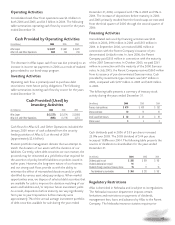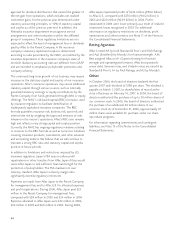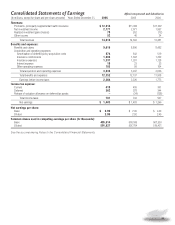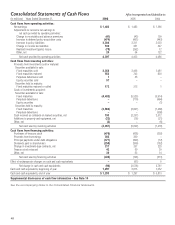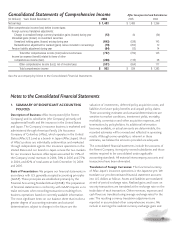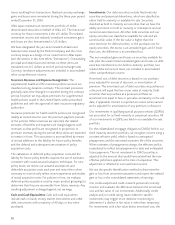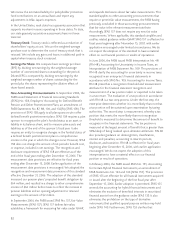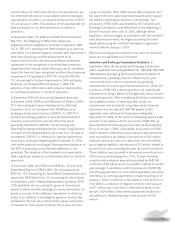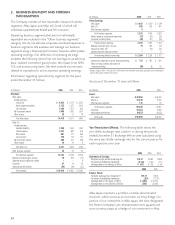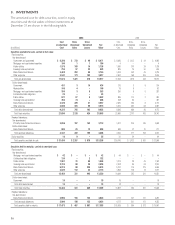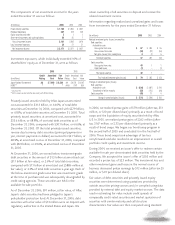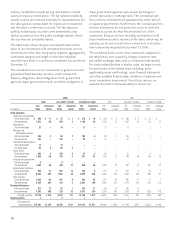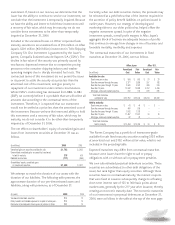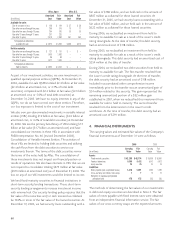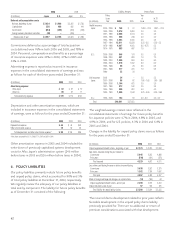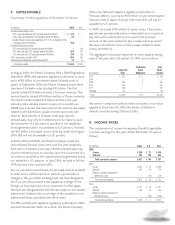Aflac 2006 Annual Report Download - page 57
Download and view the complete annual report
Please find page 57 of the 2006 Aflac annual report below. You can navigate through the pages in the report by either clicking on the pages listed below, or by using the keyword search tool below to find specific information within the annual report.
53
concentrations of credit risk in the form of subordination are
not embedded derivatives. In accordance with the standard’s
early adoption provisions, we adopted the provisions of SFAS
155 on January 1, 2006. The adoption of this standard did not
have any impact on our financial position or results of
operations.
In November 2005, the FASB issued Staff Position Number
FAS 115-1, The Meaning of Other-Than-Temporary
Impairment and Its Application to Certain Investments (FSP
115-1). FSP 115-1 addresses the determination as to when an
investment is considered impaired, whether that impairment is
other than temporary, and the measurement of an
impairment loss. It also includes accounting considerations
subsequent to the recognition of an other-than-temporary
impairment and requires certain disclosures about unrealized
losses that have not been recognized as other-than-temporary
impairments. The guidance in FSP 115-1 amends SFAS No.
115, Accounting for Certain Investments in Debt and Equity
Securities, and became effective January 1, 2006. The
adoption of this staff position did not have a material effect
on our financial position or results of operations.
In September 2005, the Accounting Standards Executive
Committee of the AICPA issued Statement of Position (SOP)
05-1, Accounting by Insurance Enterprises for Deferred
Acquisition Costs in Connection with Modifications or
Exchanges of Insurance Contracts (SOP 05-1). SOP 05-1
provides accounting guidance on internal replacements of
insurance and investment contracts other than those
specifically described in SFAS No. 97, Accounting and
Reporting by Insurance Enterprises for Certain Long-Duration
Contracts and for Realized Gains and Losses from the Sale of
Investments. SOP 05-1 is effective for internal replacements
occurring in fiscal years beginning after December 15, 2006,
with earlier adoption encouraged. Retrospective application of
this SOP to previously issued financial statements is not
permitted. The adoption of this standard is not expected to
have a significant impact on our financial position or results of
operations.
In December 2004, the FASB issued SFAS No. 123 (revised),
Share-Based Payment (SFAS 123R). This standard amends
SFAS No. 123, Accounting for Stock-Based Compensation, and
supercedes APB Opinion No. 25, Accounting for Stock Issued
to Employees, and its related implementation guidance. SFAS
123R establishes the accounting for grants of share-based
awards in which an entity exchanges its equity instruments for
goods or services. It also addresses transactions in which an
entity incurs liabilities in exchange for goods or services that
are based on the fair value of the entity’s equity instruments
or transactions that may be settled by the issuance of those
equity instruments. SFAS 123R requires that companies use a
fair value method to value share-based awards and recognize
the related compensation expense in net earnings. The
provisions of SFAS 123R, as amended by the Securities and
Exchange Commission, were effective as of the beginning of
the first fiscal year after June 15, 2005, although earlier
application was encouraged. In accordance with the standard’s
early adoption provisions, we began accounting for share-
based awards using the modified-retrospective application
method effective January 1, 2005.
Recent accounting pronouncements that were not discussed
above are not applicable to our business.
Securities and Exchange Commission Guidance: In
September 2006, the Securities and Exchange Commission
(SEC) issued Staff Accounting Bulletin No. 108 (SAB 108). SAB
108 addresses quantifying the financial statement effects of
misstatements, specifically, how the effects of prior year
uncorrected errors must be considered in quantifying
misstatements in current year financial statements. Under the
provisions of SAB 108, a reporting entity must quantify and
evaluate errors using a balance sheet approach and an income
statement approach. After considering all relevant quantitative
and qualitative factors, if either approach results in a
misstatement that is material, a reporting entity’s financial
statements must be adjusted. SAB 108 applies to SEC
registrants and is effective for fiscal years ending after
November 15, 2006. In the course of evaluating balance sheet
amounts in accordance with the provisions of SAB 108, we
have identified the following amounts that we have adjusted
for as of January 1, 2006: a tax liability in the amount of $87
million related to deferred tax asset valuation allowances that
were not utilized; a tax liability in the amount of $45 million
related to various provisions for taxes that were not utilized;
and a litigation liability in the amount of $11 million related to
provisions for various pending law suits that were not utilized.
These liabilities were recorded in immaterial amounts prior to
2004 over a period ranging from 10 to 15 years. However,
using the dual evaluation approach prescribed by SAB 108,
correction of the above amounts would be material to current
year earnings. In accordance with the provisions of SAB 108,
the following amounts, net of tax where applicable, have been
reflected as an opening adjustment to retained earnings as of
January 1, 2006: a reduction of tax liabilities in the amount of
$132 million; a reduction of litigation reserves in the amount
of $11 million; and a reduction in deferred tax assets in the
amount of $4 million. These three adjustments resulted in a
net addition to retained earnings in the amount of $139
million.


